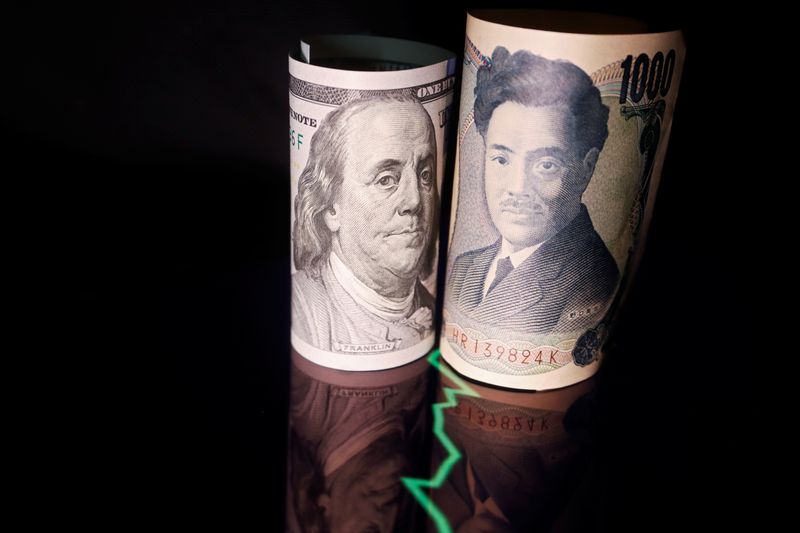Forex
Dollar gains, crosses key 145 yen level


© Reuters. FILE PHOTO: Japanese yen and U.S. dollar banknotes are seen with a currency exchange rate graph in this illustration picture taken June 16, 2022. REUTERS/Florence Lo/Illustration
By Herbert Lash
NEW YORK (Reuters) -The dollar rose on Friday after a slightly bigger increase in U.S. producer prices in July lifted Treasury yields higher even as speculation grows that the Federal Reserve is at the end of hiking interest rates.
Rebounding cost of services at the fastest pace in nearly a year pushed the Producer Price Index higher and unsettled traders who also saw the yen cross the 145-for-$1 threshold that triggered Japanese intervention in September 2022.
The PPI for final demand rose 0.3%, the Labor Department said, as data for June was revised lower to show the PPI unchanged, instead of rising by a previously reported 0.1%.
In the 12 months through July, the PPI rose 0.8% after a 0.2% gain the prior month. The PPI was forecast to climb 0.2% on the month and advance 0.7% year-over-year, a Reuters poll of economists showed.
The PPI for services increased 0.5%, the biggest gain since last August, because it contains the volatile retailer and wholesaler margins component, said Thierry Wizman, global FX and currencies strategist at Macquarie in New York.
The market also has worried that rising energy costs will push up the consumer price index (CPI), but it’s misplaced as PPI for energy was 0.0% on the month, Wizman said.
“Everyone’s concerned now about headline CPI being high because of energy prices, (but) you can’t really get overly worked up about that if PPI final demand is 0.8%, right?”
The CPI data on Thursday showed consumer inflation rose 0.2% last month, matching the gain in June, and by 3.2% in the 12 months through July.
The , a measure of the greenback against six peers, rose 0.21% as it headed to a fourth straight week of gains, up about 2.9% after bouncing off a 15-month low in mid-July on signs of a resilient U.S. labor market.
Data since then has pointed to a decelerating pace of inflation, raising bets the Fed won’t hike rates any further. But after the Treasury raised its borrowing estimate for the third quarter, yields have moved higher.
The inflation data is encouraging but achieving a sustainable Fed inflation target of 2% requires a less robust labor market, said Marvin Loh, senior global macro strategist at State Street (NYSE:) in Boston.
“The job won’t be done until we get these CPI prints that are stable around 2% and we get a jobs market that’s considered balanced,” Loh said. Meanwhile, the dollar “probably found a range.”
Futures traders now see an 88.5% likelihood that the Fed leaves its benchmark interest rate at its current range of 5.25-5.5% when policymakers meet in September. Prior to the inflation data, that chance was already above 85%.
The stronger dollar led the yen to briefly touch 145.03 in late afternoon trade, its highest since June 30.
The dollar was last at 144.95 yen, up 0.15% on the day.
“You should expect the rhetoric once yen gets to 145,” said Bank of Singapore currency strategist Moh Siong Sim. “I think the market will get a lot more careful as we get to that level.”
Japan intervened in currency markets last September when the dollar rose past 145 yen, which prompted the Finance Ministry to buy the yen and push the pair back to around 140 yen. The yen is down more than 10% against the dollar for the year.
Meanwhile, sterling rose for the first time in four days after data showed the British economy grew more than expected in June, allaying some concern about the impact of high inflation and high rates on activity.
The pound was last trading at $1.2694, up 0.15% on the day, but was still heading for a fourth weekly drop. [GBP/]
Elsewhere on Friday the euro slid 0.3% to $1.0946 and the dollar fell 0.06% against the Swiss franc.
Currency bid prices at 3:34 p.m. (1934 GMT)
Description RIC Last U.S. Pct Change YTD Pct High Low Bid
Close Change Bid
Previou
s
Session
Dollar 102.840 102.640 +0.21% -0.628% +102.91 +102.41
index 0 0 00 00
Euro/Dollar $1.0948 $1.0981 -0.31% +2.17% +$1.100 +$1.094
4 3
Dollar/Yen 144.955 144.770 +0.12% +10.56% +144.99 +144.40
0 0 50 00
Euro/Yen 158.69 158.95 -0.16% +13.11% +159.22 +158.63
00 00
Dollar/Swis 0.8763 0.8769 -0.07% -5.23% +0.8780 +0.8736
s
Sterling/Do $1.2696 $1.2676 +0.16% +4.98% +$1.273 +$1.266
llar 8 7
Dollar/Cana 1.3448 1.3449 -0.01% -0.75% +1.3465 +1.3413
dian
Aussie/Doll $0.6495 $0.6515 -0.31% -4.72% +$0.653 +$0.648
ar 4 6
Euro/Swiss 0.9594 0.9625 -0.32% -3.06% +0.9648 +0.9592
Euro/Sterli 0.8622 0.8661 -0.45% -2.51% +0.8669 +0.8622
ng
NZ $0.5985 $0.6021 -0.66% -5.80% +$0.602 +$0.597
Dollar/Doll 5 6
ar
Dollar/Norw 10.4200 10.3100 +1.16% +6.28% +10.470 +10.310
ay 0 0
Euro/Norway 11.4112 11.3320 +0.70% +8.74% +11.481 +11.324
0 4
Dollar/Swed 10.8284 10.6945 +0.91% +4.04% +10.849 +10.682
en 1 9
Euro/Sweden 11.8558 11.7485 +0.91% +6.33% +11.883 +11.748
5 8

 Forex3 years ago
Forex3 years agoForex Today: the dollar is gaining strength amid gloomy sentiment at the start of the Fed’s week

 Forex3 years ago
Forex3 years agoUnbiased review of Pocket Option broker

 Forex3 years ago
Forex3 years agoDollar to pound sterling exchange rate today: Pound plummeted to its lowest since 1985

 Forex3 years ago
Forex3 years agoHow is the Australian dollar doing today?

 Cryptocurrency3 years ago
Cryptocurrency3 years agoWhat happened in the crypto market – current events today

 World3 years ago
World3 years agoWhy are modern video games an art form?

 Commodities3 years ago
Commodities3 years agoCopper continues to fall in price on expectations of lower demand in China

 Economy3 years ago
Economy3 years agoCrude oil tankers double in price due to EU anti-Russian sanctions



























